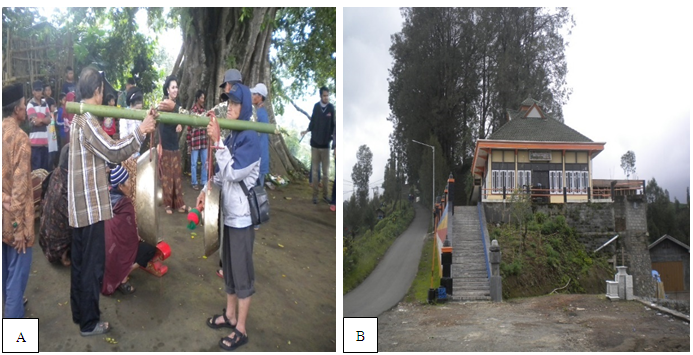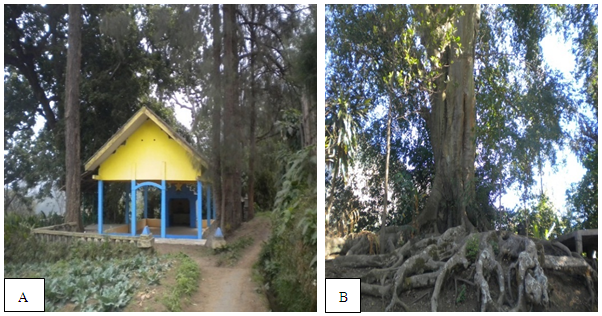-
Paper Information
- Paper Submission
-
Journal Information
- About This Journal
- Editorial Board
- Current Issue
- Archive
- Author Guidelines
- Contact Us
Advances in Life Sciences
p-ISSN: 2163-1387 e-ISSN: 2163-1395
2019; 9(1): 1-6
doi:10.5923/j.als.20190901.01

Traditional Knowledge Sacred Area: Holly Sites (Pedanyangan) in Tengger Tribe of East Java, Indonesia
Jati Batoro, Luqman Hakim, Brian Rahardi
Biology Department, Faculty of Mathematics and Natural Sciences, Brawijaya University, East Java, Indonesia
Correspondence to: Jati Batoro, Biology Department, Faculty of Mathematics and Natural Sciences, Brawijaya University, East Java, Indonesia.
| Email: |  |
Copyright © 2019 The Author(s). Published by Scientific & Academic Publishing.
This work is licensed under the Creative Commons Attribution International License (CC BY).
http://creativecommons.org/licenses/by/4.0/

This study aims to reveal the diversity of plant species, the existence of traditional conservation areas, perceptions, meanings and action (praxis) in tengger’s society, East Java. Holly's site (Danyang or petren) is a spiritual belief by the community, related to the point of view of trust, religion, and also the success raised by the groups. People believe the diversity of flora in traditional conservation areas is spiritually sacred whose existence is protected by customary rules. The relationship between local’s believe, religion, biodiversity, and environment is the local wisdom of the tengger tribe. The research method was conducted through free interviews, direct observations by surveys, and attending ceremonies of traditional rituals in traditional conservation holly sites, and worship sites or sanggar pamujan). It leads by traditional leaders called pandhita (shaman) and he is supporter called legen or wong sepuh, and also Tengger’s society. As a results of the study show that traditional rituals are still well and consistently carried out, especially in the Tengger tribe. While the diversity of plant species in the sacred area is very well maintained and respected. Traditional conservation is a combination of religious views and local beliefs, it turns out that it gets more respect than formal conservation. The diversity of plant species in the sacred area as traditional conservation includes 38 species from 33 genus and 24 families. Tengger's indigenous tribe need to have a developing status in customary law and village policy about traditional conservation sites (pedanyangan and sanggar pamujan). Conservation of protected areas and traditional knowledge can be used as a model that must be considered as the key to traditional biodiversity conservation. The community has been able to determine and utilize long-lived tree species, as well as the diversity of other plant species in traditional rituals.
Keywords: Secred area, Holly sites, Tengger tribe, East Java
Cite this paper: Jati Batoro, Luqman Hakim, Brian Rahardi, Traditional Knowledge Sacred Area: Holly Sites (Pedanyangan) in Tengger Tribe of East Java, Indonesia, Advances in Life Sciences, Vol. 9 No. 1, 2019, pp. 1-6. doi: 10.5923/j.als.20190901.01.
Article Outline
1. Introduction
- Holly site (pedanyangan, danyang, punden or petren), worship sites (sanggar pamujan), perapen or tumang in Mt. Bromo and Mt. Mahameru) are sacred areas that are used by the tengger tribes in performing every traditional event. The relationship between local belief and religion forms, a local knowledge system that is applied in the form of traditional conservation areas. Adaptation is an accumulation of ideas, perception and conception (corpus), the results of their culture by utilizing biological natural resources and the environment. The recent research and policy for biodiversity conservation needs taxonomic knowledge, ecology, conservation biology, anthropology etc. Batoro et al., [3, 4, 6] reported the land use system was adapted from indigenous knowledge which consisted of holly sites, worship sites and cemetery area.Tengger tribe is a native of East Java, which is estimated to occupy the area around Mount Bromo Tengger and Semeru in East Java around the 13th century BC and likes at an altitude of 500-2100 m ASL. They occupied at the same time the development of the Majapahit Kingdom in 1350 BC, isolating themselves and preferring to live in a cold environment, caused near the shrine of Mt. Bromo and Mt. Mahameru [4, 6].The tengger tribes areas are namely bordered by conservation areas and production forests, covering the four districts of Malang, Pasuruan, Probolinggo and Lumajang. The tengger tribes is spread in eight sub-districts with 47 villages in East Java. Bromo Tengger and Semeru has temperatures between 10°C-20°C degree and sometimes 0°C., e.g. Ranupani village, Senduro district and has latitudes between 2000-2100 m ASL [5]. People’s adaptation is an evolving ethnobiology part because of the fact of community groups or ethnic groups in an effort to overcome danger. The use of these biological sources by them contains deep and symbolic meaning.[17] reported each ethnic group has its own customs depending on their knowledge and available natural resources and environment. Paleo-botany evidence shows that human dependence on the natural environment along with biodiversity has been known since prehistory. The role of ethnic groups with all the ways of life are closely related to biodiversity and the environment [8, 20, 22].The adaptation of the tengger tribes has been through a long time process carried out from generation to generation through the socio-cultural of the economy in its environment. The relationship unites various components through the process of cultural evolution from various aspects of life and lasts until now. A harmonious and continuous relationship between the socio-cultural system and the biophysical environment (ecosystem) has been interpreted by Rambo [16, 17].These interactions lead to adaptation to knowledge system, management, utilization and impact on natural resources and the environment. Community knowledge about the use of plants as ritual materials for adaptation is not only influenced by history, customs, however the conditions of biological resources and the environment available.Human dependence on biodiversity and the way of life is closely related to cultural diversity determining the fate of the environment [8, 19, 20]. Based on the background above, the need for research focused on knowledge traditional, conservation, locations which are a manifestation of the adaptation of tengger tribe's cultural life.
2. Materials and Methods
- Research observations use qualitative research by direct interviews with the composition of informants or resource persons selected based on consideration of demographic factors. The informants were conducted through purposive sampling: traditional leaders, shaman (dukun pandhita). Shamans supporter (wong sepuh and legen) and local communities who were experts about sacred places (traditional conservation). Exploratory surveys include inventorying and identifying plant species in holly site and sacred sites. Following the traditional rituals performed by local communities tengger [8, 11, 21, 22]. The plant organs used were recorded, local names, made by herbariums, collected, identified then determined by the scientific name and classification with the flora in Java book [1].
3. Results and Discussion
- The tengger people in Bromo Tengger and Semeru areas have been going on for a long time and they have been able to adapt their lives for generations. The adaptation of life is realized through socio-cultural, economic, utilization of biodiversity and the environment in the steep and cold hilly mountains. The Tengger community has traditional knowledge, living in the Bromo Tengger Semeru and Arjuno Biosphere Reserve environments, having a unique perspective of sacred places. [14] reported, traditional knowledge is vital for sustainability of natural resources including forests, water, and agroecosystems across landscape continuum spanning from households through farms, village, commons and wilderness.In maintaining the living system due to extreme natural conditions such as cold environments, volcanic events, they have been able to maintain, manage, utilizing available natural resources. These harmonious interactions and relationships last a long time until now and are retained by them. They hold fast to ancestral cultural customs as a legacy of their ancestors who are recognized as having intrinsic value as future life capital assets for example development in generation and tourism.Preserving cultural customs can also mean preserving the knowledge of the community, the environment and the traditional sources of biodiversity in Tengger. However, currently experiencing a change in life due to the influence of external pressures such as information, education and the impact of globalization and the development of the tourism area.Tengger people’s adaptation indicated by the symbol of life including the tengger’s language, the daily wear of both men and women, such as scabbard, headgear (ketu), the color of traditional clothing with fabric that called slempang. Black clothes is for the general public, while the shaman uses white. The symbol of the sacred place, holly sites, worship sites, perapen. Mt. Bromo, Mt. Mahameru is a sacred area utilized in every traditional event.They have divided the rules of cultural customs namely covering general customs, customs relating to life and agriculture or natural disasters. [4] reported general customs (Kasada, Karo and Unan-unan) have been determined based on the tengger calendar. Whereas traditional events relating to human life include death (entas-entas), marriage event (walagara); agriculture and the consequences of danger.Places of interest in traditional cultural activities are holy sites (pedanyangan), and worship sites (sanggar pamujan). While the pedanyangan area has a certain area depending on the needs of the village, usually not broad, 0.01-1 ha or more, while the type of plant depends on the height of the location. The traditional rituals performed by the Tengger tribe are a manifestation of the adaptation of it is life and have taken place and were passed down from his ancestors. For instance of the karo customary program in the Gubuklakah village that starts from water sources, holly sites, followed by tayup dances (Figure 1A) and the same traditional karo events at Ngadas village (Figure 1B).
 | Figure 1. Location of sacred area. A. The karo ritual tayup dance and gamelan music in Gubuklakah village. B. Sanggar pamujan where traditional unan-unan events in Ngadas village |
 | Figure 2. Pujan kasada event, marit in Mt. Bromo, BTS-NP |
 | Figure 3. Danyang (holly sites). A. Holly site in Mororejo village covering Casuarina junghuhniana and Engelhardia spicata. B. Danyang is Ficus benyamina in Sapikerep village |
|
4. Conclusions
- Bonds in the Tengger tribe can unite and operate the system of traditions, cultural customs, intrinsic values that are noble from their ancestors and are an accumulation of their adaptation of life. Customary ancestral culture, local belief, traditional conservation has given value in life, peace and harmony. Preserving cultural customs has an impact on preserving ancestral knowledge, natural environment, genetic resources, conservation of biodiversity (traditional conservation), and conservation of water resources in Tengger. The traditional Tengger tribe conservation area needs to be supported by conservation efforts to prevent the loss of local knowledge and culture. Tengger's indigenous people need to have a developing status in customary law and village policy about traditional conservation sites. Religious views and local beliefs about conservation are more sustainable. The diversity of plant species in the sacred area is traditional conservation concist of 38 species from 33 genus and 24 families. The existence of a protected, sacred place by custom is a form of traditional conservation that is not accidental.
ACKNOWLEDGEMENTS
- At first we thank to the Faculty of Mathematics and Natural Sciences Brawijaya University for supporting this work throught grant DPP/SPP: 6/UN10.F09.01/PN/2018. And the second we also thank to Herbarium Brawijaya University (HBUR) and also Prof. M. Rifai for the comments on the manuscript and to all parties who helped this research.
 Abstract
Abstract Reference
Reference Full-Text PDF
Full-Text PDF Full-text HTML
Full-text HTML